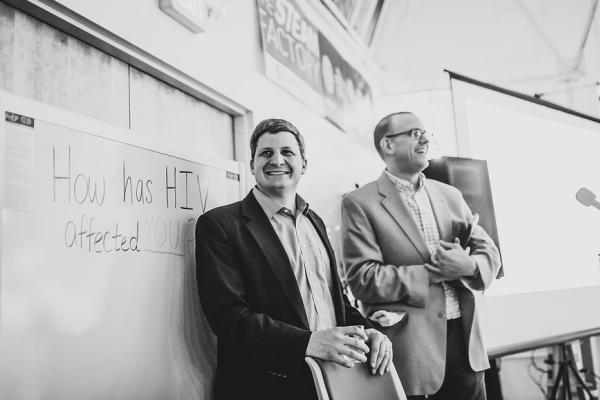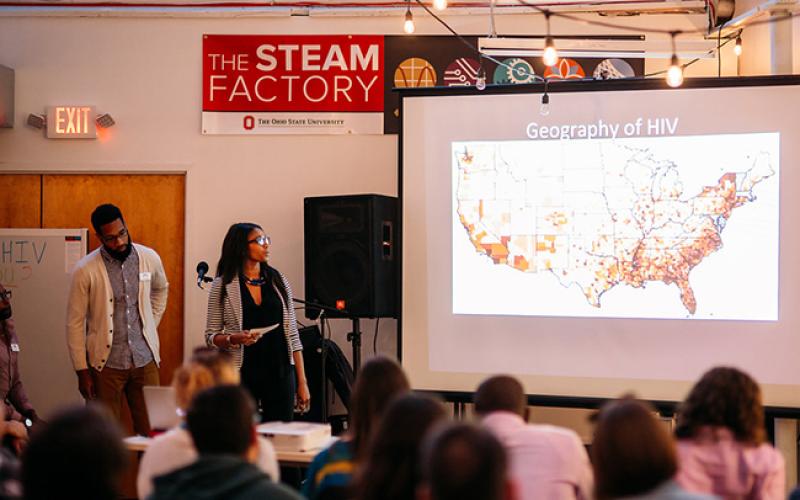History and microbiology professors co-teach course examining HIV

It’s best to view a topic as expansive and nuanced as HIV through multiple lenses.
The course HIV: From Microbiology to Macrohistory does just that.
The class is co-taught by Associate Professors Jesse Kwiek of microbiology and Thomas McDow of history. The course studies the global and historical expansion of HIV, as well as its evolution at a molecular level.
Beginning in 2014, the College of Arts and Sciences challenged faculty to develop interdisciplinary, team-taught courses. The idea was to take strengths of the college’s wide-ranging academics to shed light on subjects from a variety of angles. Both McDow and Kwiek knew each other socially and had conducted research in East Africa. The idea to form an HIV-related course that drew from both professors’ expertise quickly blossomed.
When formulating the class, transitioning between what Kwiek and McDow both wanted to share was a unique undertaking. They wanted the curriculum to have a balanced feel between HIV’s historical and microbiological perspectives.
We thought we could put a really interesting course together using HIV as an organizational framework to think about the intersection of sciences and the humanities,” McDow said. “It comes from history, which is my field, and microbiology, which is his field. But along the way, it also helps us think about ethical issues, public health, power, equality and empathy.”
McDow approaches the course from an archival perspective, delving into global historical accounts of the HIV epidemic. By studying the social, economic and political conditions of different regions of the world over the years, students explore how the virus’s path has been influenced through time.
Kwiek examines the physical progression of HIV and analyzes the trail of its existence and evolution through a microbiological context. How does the HIV microbe cause disease? What is the virus-host interaction? Why isn’t there an effective vaccine for the virus? Questions like these are asked and discussed.
McDow and Kwiek combine their two approaches, and they intersect seamlessly over the course their lectures. Instead of McDow explaining HIV’s global history one day and then Kwiek delving into HIV’s microbial evolution the next day, both professors work in tandem to present their material harmoniously.
“We’re completely unified on it,” Kwiek said. “We developed the syllabus together. We both go to every single class. When he’s talking about history, I’ll chime in about the microbiological side and vice versa. … Our goal is not to make it half microbiology and half history. It really was to mix them together and use the tools from both disciplines to get a deeper understanding of the epidemic.”
An Ohio State history professor & microbiology professor are integrating instruction with their interdisciplinary course on HIV. #ASCDaily
Over its past four iterations, the course has gained in popularity. Originally capped at 60 students, it is now capped at 80, and McDow says it has a waiting list each semester. The integrative nature of the course attracts students from all different walks of academic interests. Course participants hail from a variety of majors, including molecular genetics, microbiology, linguistics and history.
Drawing from multiple arenas of expertise and examining a topic through various contexts isn’t just a viable approach to learning about HIV. The course helps students realize the benefits of approaching other fields with a broader mindset.
“There’s a direct, obvious application of understanding the science, the genealogy, the politics and the healthcare implications of HIV,” said Michael Ibba, chair of the Department of Microbiology. “It’s that kind of knowledge they can apply to other situations. … Employers, I’m sure, would like to see someone who has a rather broad and more integrative knowledge of different fields to solve a particular problem. I think that’s what this class offers.”
Jessica Hoopengardner is a fourth-year microbiology major minoring in leadership studies and Italian. She took the class last spring after a friend of hers who took the class reported back how much she loved it.
Though she’s a microbiology major, she’d always been fascinated by history, and she thought the class was a great bridge between what she was studying and what she was interested in. She enjoyed tackling a topic from two viewpoints and seeing McDow and Kwiek play of each other and switch back and forth during lectures to teach the material.
“My biggest take way from the class is that our world is interdisciplinary and global,” Hoopengardner said.
When in my ‘regular’ microbiology classes, we learn about how bacteria interact with the immune system, but we often don't go into how this affects public health programs or where a specific bacterium came from or stigmas associated with disease. ... I think that so many of my microbiology classes could have a small public health or history component, and that would greatly benefit students by forcing them to think outside the box.”

Students conduct presentations on HIV at the STEAM Factory in downtown Columbus. Photo courtesy Paul Woo, Wandering Woo Photography
The course concludes with students conducting a group presentation at the STEAM Factory downtown using a PechaKucha-style format, in which 20 PowerPoint slides are shown for 20 seconds at a time, keeping the presentation concise and fast-paced. Hoopengardner’s presentation was about how needle-exchange programs help reduce the transmission of HIV. The event attracts representatives from local health organizations such as the Ohio Department of Health, Columbus Public Health and Equitas Health.
“Our students do good work, and it always feel like a bit of a shame to keep it in the classroom,” Kwiek said. “This gives us a chance to go out and develop good partnerships with the community.”
A study abroad course spun off the original class, and in summer 2017, 15 students traveled to the Tanzanian Southern Highlands, a region with one of the highest rates of HIV in the country. The study abroad course will commence again in the summer of 2019.
Between the course’s curriculum, the event at the STEAM Factory and the corresponding study abroad class, Kwiek and McDow have steadily turned what was once simply an idea into a multifaceted and comprehensive student experience.
“We expect [students] to think across boundaries,” McDow said. “We found that students really appreciate the opportunity to bring these things together within one class.”
Added Kwiek, “We hope to have them appreciate nuance — that things aren’t simple. If you start changing your perspective, you start seeing things differently.”
